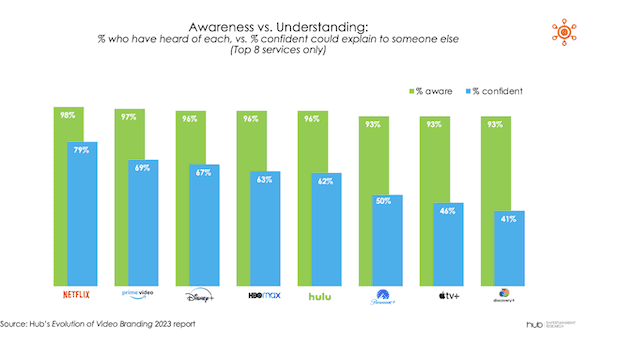As the battle between streamers rages on in the US, with their marketing spend running into the tens of millions of dollars, research by Hub Entertainment finds that consumers aren’t sure what sets a streamer brand apart from ‘another one. Instead, viewers turn to popular content or creative program brands to help them make their viewing decision.
These conclusions are drawn from the 2023 report “Evolution of Video Branding” from Hub, based on a survey of 2,400 U.S. broadband consumers, ages 16-74, who watch TV at least one hour per week and surveyed in February 2023.
Hub Entertainment explains that there is a notorious difference between knowledge of a streaming brand (in a way its notoriety) and familiarity with the brand (i.e. what it offers in terms of programs ). Thus, the study explains that the considerable sums spent by streamers have produced their effect: all the major platforms have an awareness greater than 90%.
But understanding the brand is another matter: far fewer people are able to explain to someone else what each platform does best, or how it’s different from the others. This is the case even for companies that have mastered the art of branding, such as Apple: almost all respondents are aware of Apple’s SVOD service, Apple TV+, but less than half of between them think they understand the value proposition. Ultimately, consumers choose between a set of well-known brands, without clearly understanding what differentiates them.
Finally, it is program brands that fill this gap because, faced with their inability to differentiate between platforms, consumers choose other points of reference, in particular program brands. Moreover, 41% of viewers say they have registered on a platform only to watch a specific program (compared to 35% two years ago). This phenomenon is even more marked among young people: 57% of 16-34 year olds have registered to watch a particular programme.

The study confirms this phenomenon: when lost in an ocean of content, viewers seek out what is familiar to them, so that new shows based on familiar characters or stories have a head start in the process of discovery.
As proof, 40% of respondents said they would be more inclined to watch a new show based on the Marvel universe (the highest rate of the 10 brands tested). But the following three programs are TV series that have already had successful spinoffs.

Another example mentioned by Hub Entertainment, that of the series Yellowstone, with Kevin Costner. Of those surveyed who have watched Yellowstone, nearly three-quarters (70%) have also watched at least one of Taylor Sheridan’s other series (1883, 1923, Tulsa King or Mayor of Kingstown). And the research firm adds that what’s perhaps most notable is that viewers had to go to great lengths to watch these shows: Yellowstone only airs on the Paramount cable network and on Peacock in the United States, while the other series are only available on Paramount+.

Intellectual properties (IP) are in a way safe havens for streamers who thus rely on brands known to the general public, whether books, films or sequels to series and even video games.

In conclusion, according to David Tice, senior consultant at Hub Entertainment: “Viewers have had plenty of choice of services and content over the past few years. But that can be a double-edged sword for content providers, as the huge volume makes it hard for viewers to remember what’s different about each service. But at the end of the day, content is king, and unique content will attract viewers even if the service itself isn’t unique to consumers.”
Hub Entertainment’s study confirms that audiences are now more motivated by program brands than by the platforms themselves. With the acceleration of competition between streamers, churn rates have increased and are punctuated by the launches of new seasons of the most renowned series. With each launch of a new known IP or a new season, subscribers move from one platform to another.
